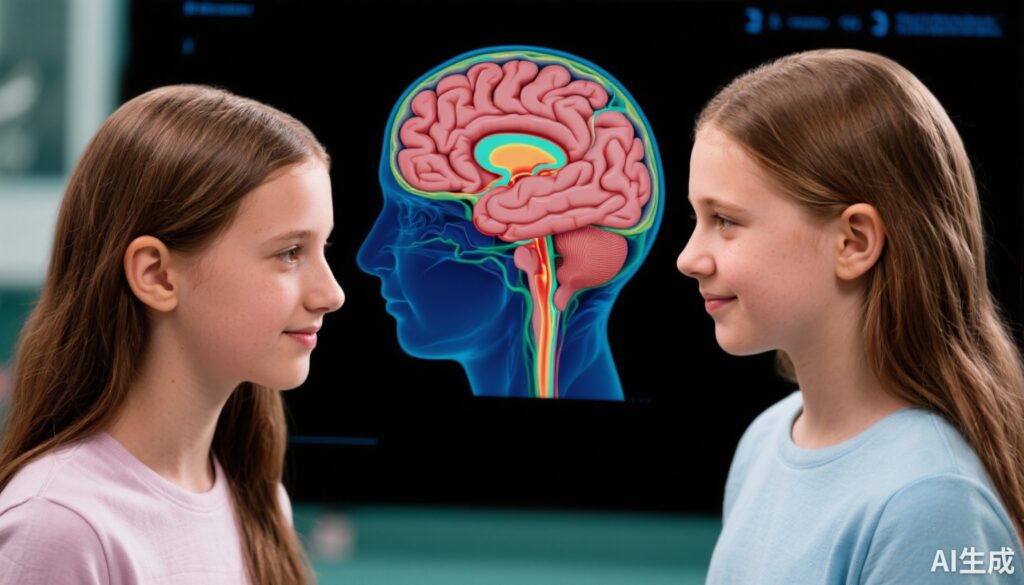Highlight
- An emotion-focused parenting intervention enhances prefrontal cortex activity related to emotion regulation in adolescent girls with internalizing symptoms.
- Increased superior frontal gyrus activation during implicit emotion regulation and decreased inferior frontal gyrus activation during explicit emotion regulation were observed post-intervention.
- Neurofunctional changes correlated with improved maternal emotion socialization and reductions in adolescent anxiety and internalizing symptoms.
Study Background
Internalizing symptoms such as anxiety and depression frequently emerge in early adolescence, especially among females, contributing significantly to global disease burden. These symptoms often persist and can lead to chronic mental health disorders if unaddressed. Parental influence, particularly maternal emotion socialization, plays a critical role in shaping adolescents’ emotional regulation capacities. While parenting interventions have demonstrated promise in improving adolescent internalizing behaviors, the neurobiological mechanisms mediating these benefits remain poorly understood. Bridging this knowledge gap is essential for optimizing intervention strategies and tailoring treatments for early emotional disturbances in youth.
Study Design
This randomized clinical trial was conducted between April 2022 and June 2024, enrolling 70 mother-adolescent daughter dyads. Eligible adolescent participants were aged 10 to 12 years and scored above the 50th percentile on the Revised Children’s Anxiety and Depression Scale, indicating elevated internalizing symptoms. Dyads were randomly assigned to either the intervention group receiving Tuning In to Teens (TINT)—a manualized emotion-focused parenting program delivered in eight weekly 1:1 sessions with mothers—or to a waitlist control group.
Functional magnetic resonance imaging (fMRI) was conducted at baseline and six months post-intervention to assess neurofunctional changes during both implicit and explicit emotion regulation tasks. The primary neuroimaging endpoints included changes in activation in key prefrontal cortex regions, specifically the superior frontal gyrus (SFG) and inferior frontal gyrus (IFG), as well as the amygdala.
Secondary outcomes focused on associations between neural activation changes and behavioral improvements in maternal emotion socialization practices regarding sadness and anxiety, alongside reductions in adolescent internalizing symptomatology.
Key Findings
The study randomized 35 dyads to the parenting intervention (mean adolescent age 11.4 years) and 35 dyads to the waitlist control (mean age 11.5 years). Neuroimaging data revealed significant modulation of prefrontal cortex activity linked to emotion regulation following the intervention. Specifically:
- Adolescents in the intervention group demonstrated increased activation in the superior frontal gyrus during implicit emotion regulation tasks relative to controls (B = 1.75; 95% CI, 0.95 to 2.54; FWE P = .002).
- Conversely, reduced activation was found in the inferior frontal gyrus during explicit emotion regulation in the intervention group compared to controls (B = -1.63; 95% CI, -2.43 to -0.84; FWE P = .03).
These neurofunctional alterations correlated with improvements in maternal emotion socialization, as indicated by reductions in unsupportive responses to sadness (Pearson r = -0.50; FDR P < .001) and anxiety (Pearson r = -0.38; FDR P = .009). Additionally, changes in brain activation patterns were associated with significant declines in adolescent anxiety symptoms (Pearson r = 0.34; FDR P = .02) and broader internalizing symptoms (Pearson r = 0.32; FDR P = .03).
The amygdala did not show significant activation changes post-intervention, suggesting that prefrontal regulatory mechanisms may be the primary neural targets of the parenting program.
Expert Commentary
This investigation provides compelling evidence that emotion-focused parenting interventions can induce measurable changes in adolescent brain function, particularly within prefrontal regions implicated in emotion regulation. The increased superior frontal gyrus activation during implicit emotion regulation may reflect enhanced automatic regulatory capacity, while decreased inferior frontal gyrus activation during explicit regulation could indicate improved regulatory efficiency or reduced exertional demand.
The association between these neurofunctional changes and both maternal behaviors and adolescent clinical outcomes underscores the bidirectional interplay between caregiving environment and adolescent neural development. This aligns with developmental psychopathology frameworks emphasizing parent-child dynamic influences on brain maturation in emotional processing circuits.
Limitations include the relatively short follow-up period and restriction to female adolescents, which may constrain generalizability. Future studies should investigate longer-term sustainability of brain changes and expand cohorts to include male adolescents and diverse populations.
Conclusion
This randomized clinical trial advances understanding of how targeted parenting interventions modulate adolescent brain function underpinning emotion regulation. By demonstrating that improved maternal emotion socialization translates into prefrontal cortex neuroplasticity and ameliorated internalizing symptoms in early adolescent girls, this study highlights the neurobiological basis for parenting interventions in mental health promotion.
These findings suggest avenues for enhancing clinical intervention frameworks by integrating neuroimaging biomarkers for treatment monitoring and refinement. Ultimately, such biologically informed approaches could improve prevention and management of adolescent internalizing disorders, with important public health implications.
Funding and Trial Registration
This study was registered with the Australian New Zealand Clinical Trials Registry (ANZCTR), identifier ACTRN12621001304820P. Funding sources were not specified in the primary publication.
References
Lin SC, Kehoe CE, Zhao J, Havighurst SS, Schwartz OS, Yap MBH, Pozzi E, Whittle S. Brain Changes After a Parenting Intervention in Adolescent Girls With Internalizing Symptoms: A Randomized Clinical Trial. JAMA Pediatr. 2025 Oct 27:e253845. doi:10.1001/jamapediatrics.2025.3845. Epub ahead of print. PMID: 41143838; PMCID: PMC12560022.



